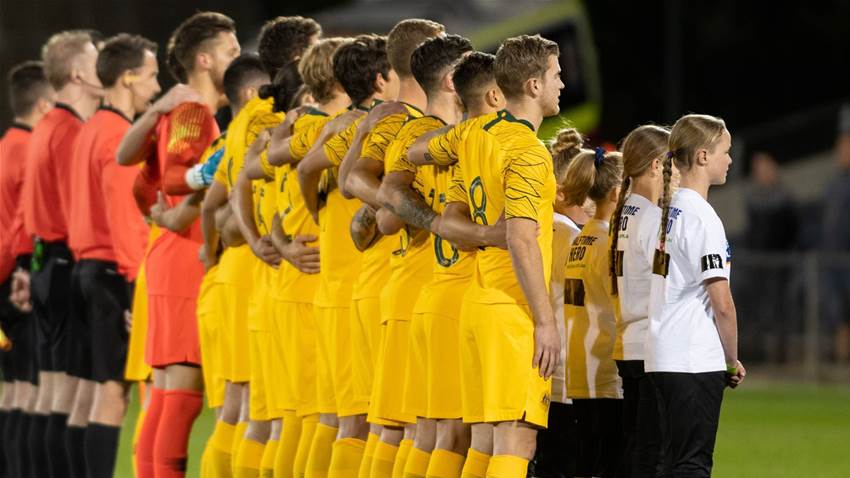Football’s enforced hibernation in the face of COVID-19 has given participants plenty of time to think about how to cure what ails it.
Unsurprisingly, a number of the solutions have centred on broadcasting rights and streaming services, in-house media apparatus and seizing the means of (television) production.
They have accompanied discussions on juniors fees, the creation of a national second division, steps to connect the Australian football pyramid, fostering a domestic transfer market and Australian youth development.
For Melbourne Victory’s Technical and Academy Director Drew Sherman, that final topic has been consuming much of his downtime thinking, and the Welshman has taken to social media to address some myths of Australian football.
“I suppose now has been a moment where a lot of people look at the bigger picture stuff,” Sherman told FTBL.
“People have more time and have had the opportunity to look at some of the bigger picture issues: What’s the state of the game like in Australia? Why is that the case? Where do we need to go from here?
“For those people that heavily work in youth development, those are the questions you always ask anyway, because you’re not producing players for now, by definition we’re producing players for 2030 and beyond.
“I think the challenge is to understand that, certainly in the space of things that you talk about now, these current players, they’re not a by-product of the existing systems.
"Youth development takes 10 to 15 years, so those players at that level now are a product of the systems that were in place 10 or 15 years ago and have been disbanded.
“In the A-League, the longest academies have been around five years; it will take another five to 10 years to assess their proficiency in terms of producing players. In the case of the clubs in Melbourne, ourselves and City – Western United aren’t even established yet – we’ve had full academies for months, not years.
“You have to understand that any assessment of current data is an assessment of a history that is not our future.”
One of the most emotive issues Sherman believes needs to be tackled is the debate surrounding game time afforded to youngsters in the A-League.
There is a lack of quality minutes available for young players in the A-League, but the Welshman believes the conversation ignores some key points around opportunities that do exist.
The 32-year-old, who worked in the youth setups of Southampton, Aldershot Town, Everton, Crawley Town and Brisbane Roar as well as served as the boss of the Cook Islands prior to arriving at Victory, believes the conversation surrounding bringing young players into the professional ranks needs to be re-framed to better reflect the reality on the ground.
“I think the biggest [misconception] is that the A-League provides a lack of opportunity, and that’s just not the case,” explained Sherman.
“Firstly, we give opportunity earlier than most leagues; the typical age of debutants in the more traditional European leagues is around 19-21, our kids are debuting at 16-19 – so they’re debuting younger.
"Secondly, there are more of them. The highest number of participants in our league, or the modal age, is 20 – there are more 20-year-olds than playing in the A-League than any other age.
“In terms of the minutes for players who are under the age of 21, the cumulative minutes, we’re right up there as one of the top five leagues in terms of the minutes we provide for players who are under the age of 21.
“The biggest challenge we have is that the minutes per player, because we have such a high volume of players, is low. We don’t give all of the players a lot of minutes, but we do provide a lot of opportunity for different players."
While players such as Louis D’Arrigo and Jerry Skotadis were notable exceptions, the median number minutes played by Australians aged 21 and under in the A-League in 2019/20 was 182 – almost half the 327-minute equivalent from the 2018/19 season. The median number of games played in accumulating those 182 minutes was six.
"There are reasons for that," Sherman explained.
“Some of that data might be down to the fact that we are mandated to contract a certain number of players and what we actually do is provide an artificial opportunity that perhaps the player quality hasn’t deserved, and that might be why we see a low average of minutes.
“We need to talk about U21s first and foremost.
“It’s no good tracking U23 data, because the salary cap mandates that the conditions for our U21 players are different from those that are 22 and 23. We can’t barrel them all together; we need to look at 16 to 21s and then 22s to 23s.
“22- to 23-year-olds, if you track the ages of players in our league, it’s staggering.
“In most leagues in the world, you see a gradual and logical rise in the number of participants to the league’s peak. If you look at the Eredivisie, between 18 when kids debut and through to 24, which is the peak age of that league, there’s a gradual rise in the number of participants and then it diminishes.
“In our league, we have a gradual rise from 16 to 21, then we see a huge decrease in the number of 22-, 23-, 24-year-olds in the league.
You would accept that if that was the first window that we were now selling players, and we were selling a player that was going to play in Europe or going to play in top leagues elsewhere, but that’s not the case and that’s seen by the transfer revenue that comes into the league.
“So why is there this huge drop in players between 22 and 24 before again, at 25 we see another spike?
“The reality is that players are too expensive because we have a minimum wage and a salary cap that makes it very hard. It makes it very hard to justify being able to spend what we have to spend on 22-, 23-, 24-year-olds that might have only accumulated a certain number of minutes.
“We actually, by having some of those conditions on minimum wage, are potentially limiting the time that we give players to mature and that’s a major, major issue.
“It becomes a very difficult decision for clubs to make because we have a limited amount we can spend, there is a big trade-off to keeping those players."
Prior to its suspension, 50 players aged between 22 and 24 - 40 of whom were Australian - played in the A-League; recording a total of 33,302 minutes at a 695.5-minute median.
“We’ve probably seen in, say Sydney, for example, where Sydney and Wanderers have been around a long time," Sherman continued.
"What those two academies have done is strengthen NPL, because the 22- and 23-year-olds typically have been going into NPL.
“Why did Sydney FC not keep Cameron Devlin? Because 22. He’s had a breakout season at 22 for Wellington but because he hadn’t played for them at 21 and he became really expensive at 22. This is the narrative that’s happening across all of our clubs.
“And that’s our big problem because there’s not the finance coming into the game in terms of transfer revenue to be able to allow the clubs to invest in being patient.”
Related Articles
.jpeg&h=172&w=306&c=1&s=1)
Langerak to bolster Victory's ALM title bid in January

Socceroo-in-waiting seals Championship deal













